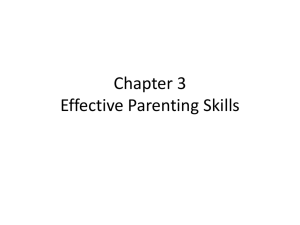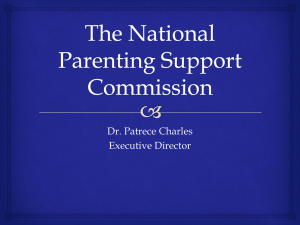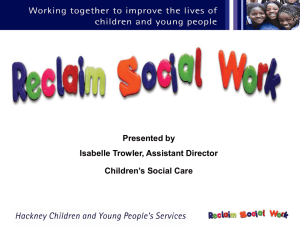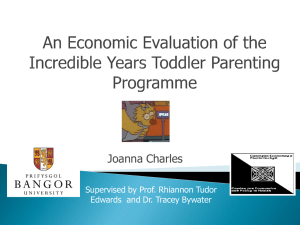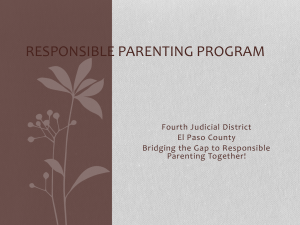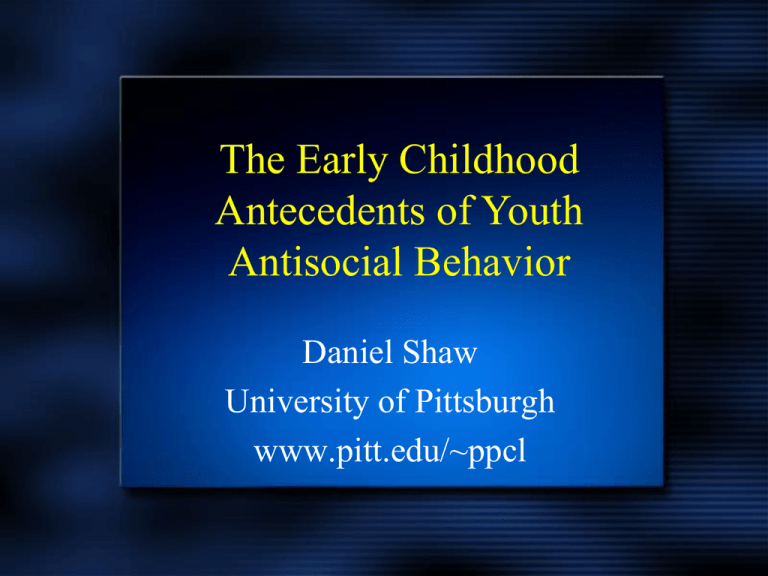
The Early Childhood
Antecedents of Youth
Antisocial Behavior
Daniel Shaw
University of Pittsburgh
www.pitt.edu/~ppcl
Special Thanks to:
Richard Bell, Joan Vondra
Kate Keenan, Emily Winslow
Elizabeth Owens, Monica Garcia
Erin Ingoldsby, Miles Gilliom
Michael Schonberg, Michael Criss
Daniel Nagin
Staff of the Pitt Mother & Child Project
Women, Infants, and Children Program
National Institute of Mental Health
Aims
Describe developmental model
of early conduct problems
Review support for components
of model
Briefly discuss implications for
further basic and applied work
The Spread
Of Antisocial
Behavior
Child Effects
Model
Parent Effects Model
Parent, Family, and Neighborhood
Developmental
Transformations:
12 to 24 Months
Increase in
undirected
anger
Walking to
toddling
12-24
Months:
Transition
to Physical
Mobility
Attachment
Theory:
Early
Starting
Conduct
Problems
(Ainsworth,
Sroufe,
Greenberg)
Sensitivity in 1st two years
promotes child compliance
By preschool age, parental
requests should be honored
differentially based on the
quality of the parent-child
relationship and the stakes
for displeasing parents
Supports parents making
investment in child early on
Patterson’s
Early
Starter
Model
PARENTS:
Deficits in Family
Management skills
Coercive
Cycles of
Interaction
CHILD
Irritability,
Hyperactivity
Child
Factors
Infancy
Emotionally dysregulated, angry,
demanding, irritable (Sanson & Prior)
Toddlerhood
Oppositional, undirected then directed
aggression, uninhibited (Keenan & Shaw)
Preschool
Oppositional, aggressive (Campbell;
Richman & Graham)
“Rejecting”
Parenting
“Reactive”
Parenting
“Proper”
Parenting
Parenting
Factors
Infancy to
Toddlerhood
PreschoolSchool-Age
Maternal
Unresponsiveness
Parental
Uninvolvement
Hostile/Rejecting
Discipline
Hostile/
Rejecting
Discipline
Siblings
Matter
Why should
sibling
relations be
important?
• First long-term peer
relationship
• Sample of behavioral
style with peer
• Does it represent a
marker of behavior
problems?
• If so, is it more than
a marker?
Totals
Demographic
Characteristics
of Sample
Sex of child
310 boys
Yearly Income
$12,708
Mother’s age
28, range 17-43
Maternal education
12.6 years
% Married/
Living Together
62
% White/Afr. Amer.
53/36
Criminality
36%
Pitt Mother & Child Project:
Follow-Up Schedule
1 yr. 1.5 yr. 2 yr. 3.5 yr. 5 yr. 5.5 yr. 6 yr. 8 yr. 10 yr. 11 yr. 12 yr. 15 yr. 17 yr. 20. yr
Lab Lab
Lab/ Lab
Home Home Lab Home Home Lab Home Home Home Home
Home
Twice
---- Camp ------ Court Data ------------Teacher and School Data -------
Measurement Strategies
Focus on observation of developmentally salient
issues (e.g., maternal responsiveness & infant
persistence at age 1, discipline practices at age 2)
Assess in multiple contexts (e.g., home,
lab, summer camp, school) with observations of
target child interacting with parents, sibs, peers,
best friends, and romantic partners
Supplement observations with reports of family,
child, and community risk factors using multiple
family members, peers, best friends, romantic
partners, teachers, school and official records
High Chair Task at 1 yr: Maternal Responsiveness and Infant
Persistence
Measures
Child Noncompliance at 2 yrs: observed during clean-up task
Behaviorial Inhibition at 2 yrs: In response to distressing gorilla
sounds
Parenting Practices at 1.5 & 2 yrs: Hostile/Rejecting based on
molecular and global ratings during clean-up task
Sibling Conflict at 5 yrs: Verbal and physical conflict between
target child and closest-age sib during 1 hour directed play session
Maternal Resources: HOME Acceptance (2 yrs.), Beck Depression
Inventory (1.5 to 5 years), General Life Satisfaction (1.5 yrs.), and
Parenting Daily Hassles (1, 5, 2, & 3.5 yrs.)
Child IQ at 5.5 yrs: 4 subscales of the WPPSI-R
Achenbach CBCL/TRF at 2, 3.5, 5, 6, & 8 yrs: Externalizing,
Aggression, and other DSM-based factors
Elliott Self-Report of Delinquency at 10, 11, 12, 15, 17 yrs.
Child and Parenting Predictors: Boys
.29*
Persistence
(12 Months)
.38**
.19x
Noncompliance
(24 months)
CBCL
Externalizing
Problems
(24 months)
-.33**
Maternal
Responsiveness
(12 months)
Maternal
Rejection
(24 months)
.70***
CBCL
Externalizing
Problems
(42 months)
.18x
.39**
-.23*
x
p < .10, * p < .05, ** p < .01, *** p < .001
Shaw et al. (1998), Journal of Abn. Child Psych.
66
Mother Report CBCL
Aggressiont-score
Two-way
interaction between
rejecting parenting
and sibling conflict
in predicting CBCL
Aggression at age
5/6
64
62
High Sib
Conflict
Low Sib
Conflict
60
58
56
54
-1 SD
+1 SD
Rejecting Parenting
Garcia, Shaw, Winslow, & Yaggi, 2000
Developmental Psychology
sibling conflict in
relation to TRF
Aggression at age 6
Teacher Report TRF
Aggressiont-score
Two-way
interaction between
rejecting parenting
and
58
57
56
55
54
53
52
51
50
High Sib
Conflict
Low Sib
Conflict
-1 SD
+1 SD
Rejecting Parenting
Trajectories Leading to Clinically-Elevated Scores on
TRF Aggression at age 8: CBCL Aggression at Ages 2,
3.5, 5, & 5.5
68
66
CBCL
Aggression
64
62
60
Nonproblem
at or > 90th %
58
56
54
52
2
3.5
5
5.5
Age of Child in Years
Effect size = -.1 - .48 sd
Shaw, Bell, & Gilliom, Clinical Child
and Family Psychology Review (2000)
Trajectories Leading to Clinically-Elevated Scores on
TRF Aggression at age 8: Maternal Depressive Symptoms
At Ages 1.5, 2, 3.5, and 5.5
16
14
Maternal
Depressive
Symptoms
12
10
8
Nonproblem
at or > 90th %
6
4
2
0
1.5
2
3.5
5.5
Effect size = .27 - .73 sd
Trajectories Leading to Clinically-Elevated TRF
Aggression Scores at Age 8: Maternal Social Support
at Age 1.5
55
Maternal
Social
Support
50
45
40
35
Nonproblem
> 90th %
Effect size = .80 sd
Trajectories Leading to Clinically-Elevated TRF
Aggression at age 8: HOME Total at Age 2
35
HOME
Total
33
31
29
27
25
Nonproblem
at or > 90th %
Effect size = .56 sd
Developmental Trajectories of Overt Antisocial Behavior
Overt Antisocial Behavior
7
6
5
4
3
2
1
0
2
3.5
5
Age (years)
6
8
Low-actual
Mod. desister-actual
High desister-actual
Chronic-actual
Low-pred.
Mod. desister-pred.
High desister-pred.
Chronic-pred.
Shaw, Gilliom, Ingoldsby, & Nagin (2003), Developmental Psychology
3 factors
that
distinguished
high and low
truly earlystarting
antisocial
trajectories
from ages 2
to 8
• Child fearlessness
• Maternal depression
• Maternal caregiving
Age 11-12
Elliott Self
Report
Delinquency
Follow-Up
to Youth &
Teacher
Reports of
Adolescent
Antisocial
Behavior
.21***
.20*
.21*
Observed
Rejecting
Parenting: Age 2
.26*
Age 15
stole something
from a car
picked up by police
and brought to
station
arrested
.16+
marijuana use
.21***
.19*
Achenbach
TRF
Externalizing
having sex
*** p < .001, * p < .05, + p < .10
Developmental Trajectories of Youth Antisocial Behavior Ages 10-17
4 group solution with highest BIC score, all posterior probabilities > .85
Trajectory
Group
Differences
on Juvenile
Court
Petitions
• Low Stable -- 62% of sample: 25%
• High ‘Decreasing’ -- 5% of sample:
60%
• Late Increasing --10% of sample:
49%
• High Increasing -- 22% of
sample:78%
Trajectory
Group
Differences
based on
Early
Childhood
Risk Factors
Accounting for all other predictors in
early childhood,
• Factors that discriminated high
increasers from low stable: maternal
depression at ages 1.5-3.5 years
• Factors that discriminated ‘high
decreasing’ group: rejecting parenting
and maternal depression
Methods: Assessing Threat
• Functional Imaging
• Amygdala reactivity paradigm – angry, fearful, neutral and
surprised faces
•
3T platform
–
–
•
•
•
Gradient echo EPI sequence: TR/TE = 2000/25msec
34 slices = 3 mm thick
Processed using the GLM of SPM8
Individual contrast images of Faces > Shapes were entered into a second level random effects
models
Extracted individual values for the main effect of task for the cluster and maximum voxel and did
analyses outside of SPM8
Amygdala
reactivity
and AB
Trajectory
Groups
(N = 51)
Summary of Findings
For boys, child and parenting precursors of
serious antisocial behavior identifiable from
1.5-2 years of age
- Emphasizes the salience of both child behavior and
parental response to such behavior in the 2nd year
Factors that compromise parenting also related to
persistence of conduct problems
- Maternal depression, social support
Implications and challenges for early identification
and treatment
- Multisystemic approach warranted
- not child but dyad at risk
Continued
Follow-Up
of Sample
during
Early
Adulthood
• Combine all data collected on youth
adjustment and their social environments
from birth to through adolescence with
genetic data (collected at age 17) and tobe-collected brain function data (at ages
20 and 22) in relation to antisocial
behavior and drug use during early
adulthood
• Will also allow us to examine potential
protective roles of quality of instrumental
functioning (e.g., steady employment,
higher education) and social relationships
(e.g., stable and positive relationship with
significant other) during the early 20’s
The Early Childhood
Antecedents of Youth
Antisocial Behavior
Daniel Shaw
University of Pittsburgh
www.pitt.edu/~ppcl




